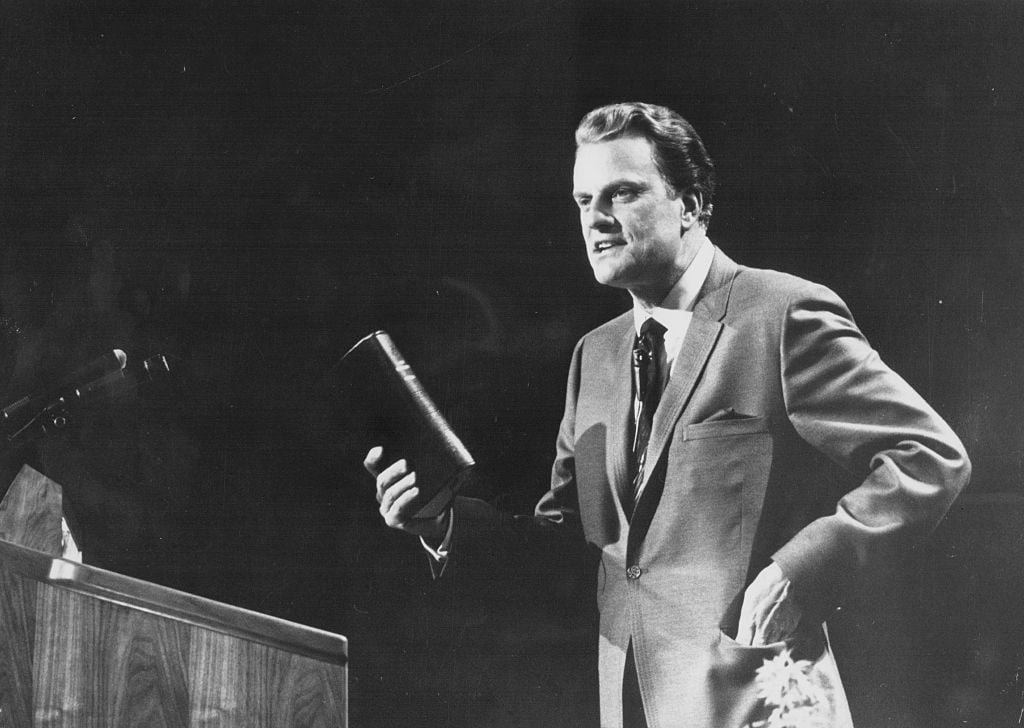
* * * *
One theme here involves the difficulties in considering the Bible inerrant in every “jot and tittle.” Without error of any kind, grammatical, scrivener’s, whatever. And that every Bible “fact” must be accepted as literally true, even to the point of accepting the earth as only 6,000 years old. That view seems flawed,* but the short and simple answer is that the Bible is inerrant “in all that it affirms.” That was good enough for Billy Graham and it’s good enough for me.
Of course we are nearing the end of Advent – Christmas Day is next Sunday – and I did just promise to write more about “Andrew, Advent and The 12 DAYS of Christmas.” I’ll say more about those later, with links in the notes for more information. But getting back to the difficulties in translating the Bible, one big difficulty involves translating from the original Hebrew. For one thing ancient Hebrew, the kind used to write the original Old Testament (or at least the Torah), had no vowels. It had only consonants, and all the consonants in a sentence were strung together. Also, there was no punctuation, so sentences too were just “strung together.”
That style of writing is called Scriptio continua. It has no spaces or other distinguishing marks between either words or sentences. The letters – all capitals – are simply strung together, page after page. Take for example a sentence in English, “The man called for the waiter.” In Biblical Hebrew the sentence would read, “THMNCLLDFRTHWTR.” But that sentence could also read, when translated into English, “The man called for the water.” And again, that sentence would have no period to mark its end, or space to mark the beginning of the next sentence coming up. That next sentence would start right up without any “break in the action.”
Another point: When the Torah was written only a very few people could read at all, and fewer still could write. So what they ended up doing was relying on a trained mentor. A mentor who had memorized what all those strung-together letters actually meant. Which brings up Tradents. And that’s something I only learned about recently, by watching a course lecture taught by Professor Gary A. Rendsburg, on The Dead Sea Scrolls.
In Lecture 11 of the course – “Biblical Manuscripts at Qumran” – Professor Rendsberg made some interesting points. For one thing, he said that back in Old Testament time, “texts were produced in two versions: oral and written. Scribes copied the text over and over again, while tradents transmitted the text orally from generation to generation (though most likely they held a text in their hands as a guide).” This was after noting again that at that time, Hebrew had only consonants: no vowels or punctuation marks. (See also TRADENT English Definition and Meaning.)
So, what’s the point? Just that when Moses wrote the Torah he had no vowels or punctuation marks to work with. (Which raises another question: When and where did he learn to write Hebrew?) And in the years after Moses died, the scrolls he worked with got worn out, and so they had be copied, over and over again. And that was a two-step process, involving tradents and that person or persons doing the actual writing. So basically the written version – with no vowels or spacing between words and sentences – operated as kind of a “cheat sheet.”
But only in the sense of a paper with “summarized information used for quick reference.”
In otber words, Tradents worked with the actual writers, the scribes. They kept the oral tradition alive by telling the person copying the ancient texts – as they wore out – just what all those jumbled-together consonants and sentences actually meant. So in the original, the books of the Torah especially were handed down from generation to generation using a two-part process. The person copying the original worked with a tradent. The tradent knew the text from memory, and he – again – passed on just what those strung-together symbols actually meant.
So according to this theory, the person copying down the words had to use the original writing as kind of a “cheat sheet,” and needed a “tradent” to fill in the blanks. So “writing” the Old Testament was originally a two-step process. One person transcribed but needed both the original written text and an “elder” to give that text its full meaning.
Beyond that, all that information had to be passed on to whoever was going to read this scriptio continua, out loud, in a synagogue every Sabbath. That was because up until at least a thousand years after Jesus – to the time of Gutenberg – precious few people could read at all. And other information about scriptio continua – as detailed in the notes – indicate the reader of such a strung-together text was more of a “trained performer.” And such a trained performer had a lot more room for subjective ambiguity than would be possible in reading the Bible today.
Which is enough of “giving a Southern Baptist apoplexy,” for now. As for St. Andrew, the end of Advent and Christmas, see the links in the notes. But some things to point out: 1) Andrew was the “First Apostle,” the one who first brought Peter to meet Jesus. 2) It wasn’t just Guy Lombardo who said “it’s later than you think,” back in 1949.* The same view was expressed in Ecclesiastes 5:18, “It is good and fitting for one to eat and drink, and to enjoy the good … all the days of his life which God gives him; for it is his heritage.” And 3) Christmas isn’t just one day:
The Twelve Days of Christmas is the festive Christian season [including “Twelfth Night”] beginning on Christmas Day … that celebrates the birth of Jesus Christ, as the Son of God. This period is also known as Christmastide… The Feast of the Epiphany is on 6 January [and] celebrates the visit of the Wise Men (Magi) and their bringing of gifts to the child Jesus. In some traditions, the feast of Epiphany and Twelfth Day overlap.
Which means the Three Wise Men didn’t visit Jesus in the manger on the night He was born. (Christmas Eve.) Instead they came some time later, as I’ll explain in the next post. Also in a later post I’ll explain how the original “Christian Mystic” was Jesus Himself. Stay tuned!
* * * *
The upper image is courtesy of Young Billy Graham Images – Image Results. See also Billy Graham – Wikipedia. The “grace and knowledge” refers to 2d Peter 3:18: “But grow in the grace and knowledge of our Lord and Savior Jesus Christ. To him be glory both now and forever!”
“Mystical” and “corporate.” See The Online Book of Common Prayer, at page 339, the post-communion prayer in The Holy Eucharist: Rite One.
Re: Age of the earth. According to How Old Is Earth? | Britannica, it’s more like 4.4 billion years old, while Age of Earth Collection | National Geographic Society says “4.54 billion years old, plus or minus about 50 million years.”
Re: Billy Graham. He agreed the Bible was inerrant in all that it affirms when he took part in shaping the Lausanne Covenant. (The July 1974 manifesto promoting active worldwide Christian evangelism.) See Billy Graham, Evangelism, Evangelicalism, and Inerrancy:
We affirm the divine inspiration, truthfulness and authority of both Old and New Testament Scriptures in their entirety as the only written word of God, without error in all that it affirms, and the only infallible rule of faith and practice. (Emphasis added.)
That was also the view of John R. W. Stott (1921-2011), the Anglican cleric who Time magazine ranked among the world’s 100 most influential people. In his book, Understanding the Bible, and on pages 140-143, made three key points. His first point was that the process of God’s inspiring the Bible “was not a mechanical one. God did not treat the human authors of Scripture as dictating machines or tape recorders.” He said God spoke to the Bible writers in different ways, sometimes through dreams and visions, “sometimes by audible voice, sometimes by angels.”
Re: “Scriptio continua,” the writing style with no spaces or other distinguishing marks between words or sentences. “The role of the scribes was to simply record everything they heard to create documentation. Because speech is continuous, there was no need to add spaces.” In turn, the person who read the scroll-text out loud – most people were illiterate – was a “trained performer.” He would memorize the “content and breaks of the script.” In turn, during such “reading performances, the scroll acted as a cue sheet:” Also, the “trained performer” had the liberty to insert pauses and dictate tone, which made the act of reading significantly more subjective.
Re: St. Andrew, Advent and the coming Christmas season. See On Andrew – “First Apostle” – and Advent, from 2016, and from last year, Advent 2021 – “Enjoy yourself.” Because – in the midst of a new COVID variant – “it’s later than you think.” For some views on Christmas see On the 12 days of Christmas, 2018-2019, and On the 12 DAYS of Christmas – 2021-22. As to Guy Lombardo, the Advent 2021 post led off with a picture of an album cover of his, featuring the “Enjoy yourself” song. This was after noting that at the time of posting there was a “new Covid in town,” the Omicron variant, and that as of December 5, 2021, “COVID that has already claimed the lives of 803,045 Americans.”
* * * *

